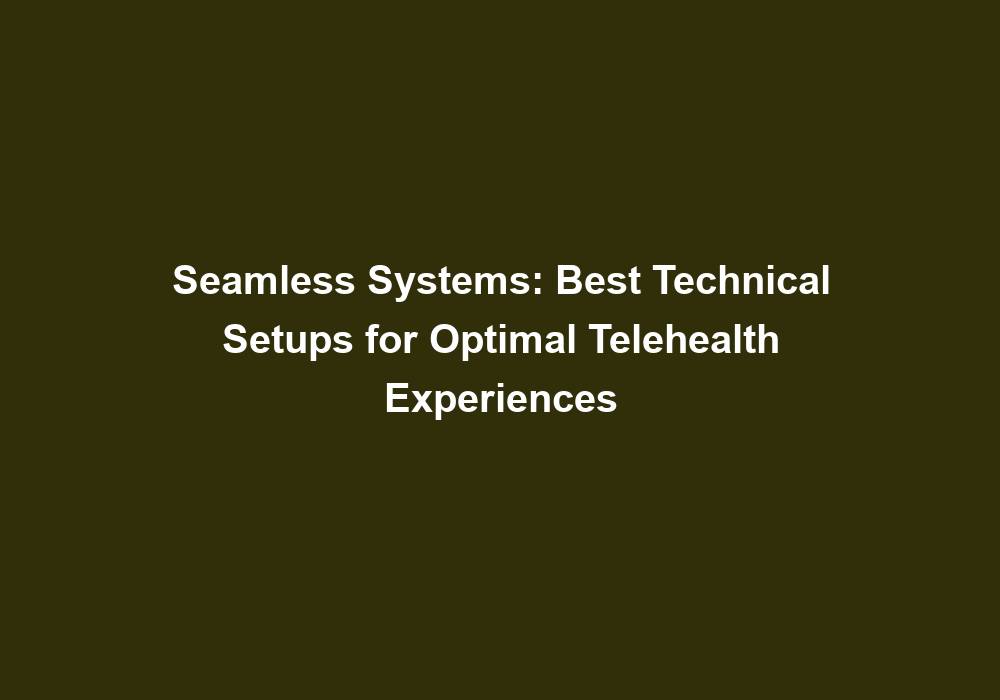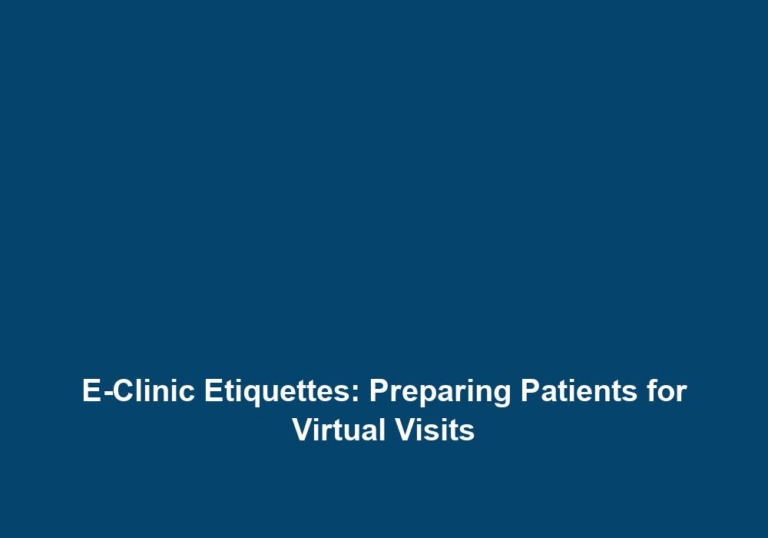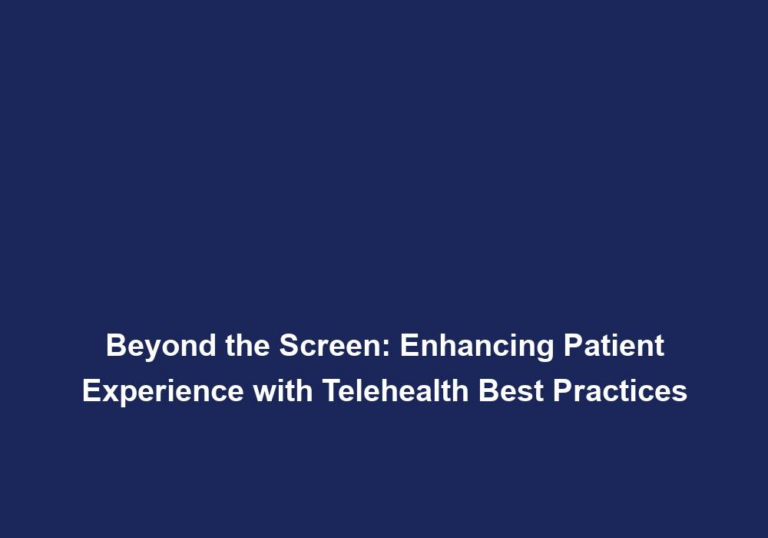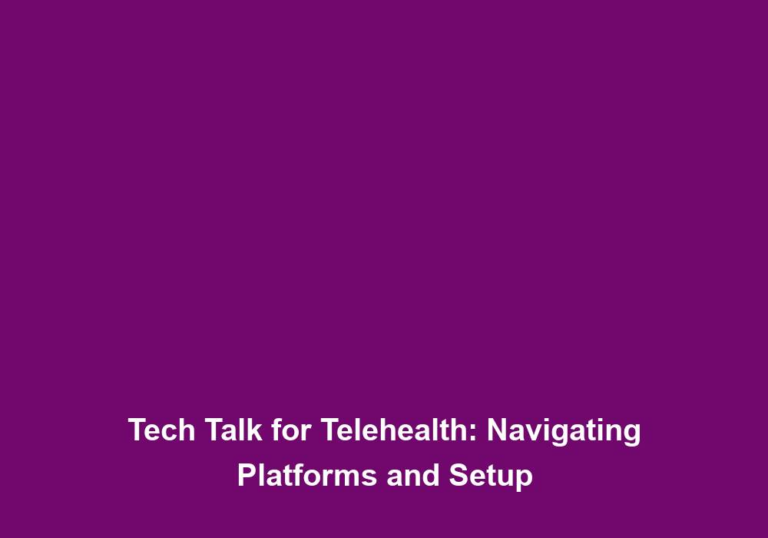Seamless Systems: Best Technical Setups for Optimal Telehealth Experiences
In today’s ever-evolving world, telehealth has become an essential component of the healthcare industry. It allows patients to receive medical care remotely, ensuring access to healthcare services irrespective of geographical barriers. To offer a seamless and effective telehealth experience, it is imperative to have the right technical setups in place. In this article, we will discuss the best practices and recommendations for achieving optimal telehealth experiences through seamless systems.
1. Reliable Internet Connectivity
A fundamental requirement for successful telehealth experiences is a reliable internet connection. Both healthcare providers and patients must have access to a stable and high-speed internet connection to ensure uninterrupted video and audio communication during telehealth sessions. It is recommended to have an internet connection with a minimum speed of 5 Mbps for smooth video conferencing and data transmission.
To ensure a reliable internet connection, healthcare providers and patients should consider the following:
- Choose a reputable internet service provider (ISP) that offers high-speed and stable internet connections.
- Use a wired Ethernet connection instead of relying solely on Wi-Fi, as wired connections tend to be more stable and less prone to interference.
- Position the router in a central location to maximize signal strength and minimize potential obstructions.
- Regularly test the internet connection speed to identify any issues and address them promptly.
Having a reliable internet connection is essential for delivering telehealth services without interruptions or delays, ensuring a seamless experience for both healthcare providers and patients.
2. Secure and HIPAA-compliant Platforms
Privacy and security are crucial aspects of telehealth. When choosing a telehealth platform, it is essential to prioritize HIPAA-compliance to protect patient information and ensure confidentiality. Look for platforms that offer end-to-end encryption and secure data storage to safeguard sensitive medical records. It is also important to educate both healthcare providers and patients on best practices for protecting their privacy during telehealth sessions.
To ensure secure and HIPAA-compliant telehealth experiences, consider the following:
- Choose a telehealth platform that complies with HIPAA regulations and has undergone a third-party security assessment.
- Verify that the platform uses encryption protocols to protect data during transmission and storage.
- Implement strong access controls, such as two-factor authentication, to prevent unauthorized access to patient information.
- Regularly update the telehealth platform and associated software to patch any security vulnerabilities.
Educate healthcare providers and patients about the importance of using secure passwords, avoiding sharing sensitive information during telehealth sessions, and being mindful of their physical surroundings to prevent unauthorized individuals from accessing confidential information.
3. High-Quality Audio and Video Equipment
To facilitate clear communication and diagnoses, it is crucial to invest in high-quality audio and video equipment. Healthcare providers should use professional-grade webcams, microphones, and speakers to ensure optimal audio and video quality during telehealth consultations. Similarly, patients should be encouraged to use devices with good audio capabilities, such as smartphones, tablets, or computers with built-in webcams and microphones.
Consider the following tips for high-quality audio and video during telehealth sessions:
- Use a high-resolution webcam to ensure clear video transmission.
- Invest in a good quality microphone to capture clear audio without background noise.
- Check the lighting in the room to ensure clear visibility during video consultations.
- Encourage patients to use headphones or earphones to improve audio clarity and reduce background noise.
By using high-quality audio and video equipment, healthcare providers can enhance the telehealth experience, allowing for accurate assessments and effective communication with patients.
4. User-Friendly Interface and Accessibility
Telehealth platforms should have a user-friendly interface that is easy to navigate for both healthcare providers and patients. A well-designed interface reduces the learning curve and enhances the overall telehealth experience. Accessibility features, such as closed captioning and language translation options, should also be considered to cater to diverse patient populations. Additionally, platforms should be compatible with different operating systems and devices to ensure accessibility for all.
To ensure a user-friendly and accessible telehealth platform, consider the following:
- Conduct usability testing with healthcare providers and patients to identify any navigation or usability issues and make improvements accordingly.
- Implement intuitive design elements, such as clear icons and labels, to guide users through the platform.
- Provide language translation options to accommodate non-English speaking patients.
- Offer closed captioning for patients with hearing impairments.
- Ensure compatibility with popular operating systems, web browsers, and devices to accommodate a wide range of users.
By prioritizing a user-friendly interface and accessibility, healthcare providers can ensure that patients can easily navigate the telehealth platform and have a seamless experience during their virtual consultations.
5. Integration with Electronic Health Records (EHR) Systems
Seamless integration with existing Electronic Health Records (EHR) systems is crucial for efficient telehealth experiences. Telehealth platforms should be able to integrate with EHR systems to enable healthcare providers to access and update patient records seamlessly. This integration eliminates the need for duplicate data entry and ensures a comprehensive view of a patient’s medical history, leading to more informed diagnoses and treatment decisions.
To achieve successful integration with EHR systems, consider the following:
- Choose a telehealth platform that offers seamless integration with popular EHR systems.
- Ensure that patient data is securely transferred between the telehealth platform and the EHR system.
- Train healthcare providers on how to navigate and utilize the integrated EHR features within the telehealth platform.
- Regularly update the integration to ensure compatibility with any EHR system updates.
By integrating telehealth platforms with EHR systems, healthcare providers can streamline their workflows, access relevant patient information efficiently, and provide comprehensive care during telehealth consultations.
6. Reliable Technical Support
Technical issues can arise during telehealth sessions, disrupting the flow and effectiveness of the consultation. To overcome these challenges, it is essential to have reliable technical support available to assist healthcare providers and patients promptly. Technical support should be accessible through multiple channels, such as phone, email, or live chat, to address any connectivity or software-related issues efficiently.
To provide reliable technical support for telehealth, consider the following:
- Have a dedicated support team available during telehealth sessions to address any technical issues promptly.
- Offer multiple channels for contacting technical support, such as a dedicated phone line, email, or live chat.
- Provide clear instructions on how to access technical support and troubleshoot common issues.
- Regularly train technical support staff to stay updated with the latest telehealth technologies and troubleshooting techniques.
By having reliable technical support in place, healthcare providers and patients can resolve any technical issues quickly, ensuring a smooth and uninterrupted telehealth experience.
7. Training and Education for Users
Regardless of how seamless a telehealth system may be, its effectiveness ultimately relies on how well users understand and utilize its features. Training and education should be provided to both healthcare providers and patients to ensure they are comfortable and proficient in using the telehealth platform. This includes educating healthcare providers on best practices for conducting virtual examinations and guiding patients on how to navigate the platform for scheduling appointments, accessing medical records, and participating in telehealth consultations.
To ensure effective training and education for telehealth users, consider the following:
- Conduct comprehensive training sessions for healthcare providers to familiarize them with the telehealth platform’s features and functionalities.
- Provide user manuals or video tutorials to guide healthcare providers and patients through the telehealth platform’s usage.
- Offer ongoing support and refresher training sessions to address any questions or concerns that arise.
- Collaborate with healthcare organizations or associations to develop standardized training materials for telehealth.
By investing in training and education for telehealth users, healthcare providers can maximize the benefits of telehealth, improve patient satisfaction, and ensure a seamless telehealth experience for all involved.
Conclusion
Telehealth offers numerous benefits, such as increased accessibility to healthcare services, reduced travel costs, and improved patient outcomes. However, to deliver optimal telehealth experiences, it is crucial to have the right technical setups in place. This includes reliable internet connectivity, secure and HIPAA-compliant platforms, high-quality audio and video equipment, user-friendly interfaces, integration with EHR systems, reliable technical support, and comprehensive training for users. By implementing these best practices, healthcare providers can ensure seamless telehealth experiences that prioritize patient care and convenience.







